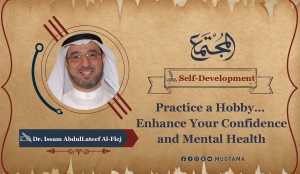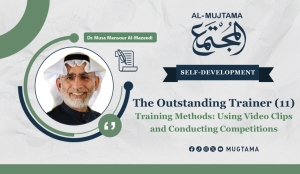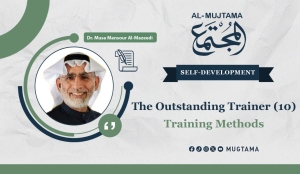Practice a Hobby… Enhance Your Confidence and Mental Health
February 17, 2025
I met Dr. Adel Al-Zayed a few years ago at one of the hotels on Hamra Street in Beirut over breakfast at around 8:30 AM. He told me that he had just returned from a diving trip that started at 6 AM, as it is a pleasant hobby he enjoys while traveling, where there is ample time and new places to explore.
We had a delightful conversation about his love for exploration and travel, whether on foot at times or by bicycle at others. It is a hobby associated with training, knowledge, reading, and culture, not merely intellectual luxury but rather a pursuit of scientific enrichment and broad horizons. That is why I find him full of confidence in what he says—how could he not be when he is a consultant in psychiatry whom the Faculty of Medicine at Kuwait University lost?
Practicing any hobby enhances an individual’s confidence and mental health, regardless of whether they are male or female, young or old, a scholar, an intellectual, or an ordinary person, wealthy, middle-class, or poor, religious or not. This is why we find that great leaders engage in their own hobbies according to their physical, mental, and motor abilities. For example, Prince Charles, the Prince of Wales and heir to the British throne, plays polo and enjoys painting; Russian President Vladimir Putin practices tennis and judo; former Egyptian President Hosni Mubarak played squash; Sultan Abdul Hamid II enjoyed woodworking; and the late Emir Sheikh Sabah Al-Ahmad, may Allah have mercy on him, practiced falconry and fishing. Similarly, social figures such as Abdulaziz Al-Babtain were passionate about hunting and literature, while Sheikha Suad Al-Sabah loved literature and poetry, and so on.
We should promote this culture among our generations—it is better late than never. Let us encourage our children, both boys and girls, according to their interests and abilities. They should have more than one hobby, both at home and outdoors. A hobby is not limited to sports alone; in fact, I consider sports more of a key to maintaining general health rather than merely an entertaining hobby. There are many other hobbies, such as drawing, reading, writing, manual design, computer programming, farming, fishing, hunting, raising livestock, photography, videography, acting, public speaking, radio hosting, sewing, embroidery, cooking, cycling (both regular and motorized), various sports, car and machinery repair, and more. Some even reach a professional level in their hobbies, creating innovations and new ideas.
There are hobbies that can be practiced individually and others that are group-based, each with its own advantages, allowing knowledge exchange and collective enjoyment. Examples include motorcycle clubs, the "Wathiq" project for promoting values in schools, and recycling teams, among others. Scientifically, all these activities have been proven to enhance mental well-being, self-confidence, a sense of achievement, and resilience against failure, weakness, or dependency.
Therefore, state institutions should support such hobbies and facilitate their practice when needed, investment institutions should provide financial backing, and civil society organizations should offer moral and logistical support. Strengthening hobbies within a society reduces social and behavioral problems, particularly bullying.
Engage in a hobby that boosts your confidence and mental health, whatever it may be. Start now if you haven’t already—you will notice a significant difference in yourself and those around you. Do not succumb to discouragement, enjoy the experience, and remember to pray for me.
-------------------------------------------------------------
Source: Al-Anbaa, 20/10/2020.
The Outstanding Trainer (11) Training Methods: Using Video Clips and Conducting Competitions
February 10, 2025In this article, we continue presenting captivating training methods that grab the trainees' attention:
- Video Clips Presentation:
Presenting video clips is one of the most effective ways to solidify principles in the trainees' minds, as well as an important method to break routine and eliminate boredom during training sessions.
However, trainers should be aware that some video clips are copyrighted and come with the training product. There are also public administrative and leadership clips available on platforms like YouTube, along with outstanding real-life films produced by Hollywood, containing excellent clips. Additionally, trainers can use videos they have produced themselves.
The trainer should ensure that each video clip does not exceed 10 minutes, as long clips may lead to boredom.
Example (1): In a time management workshop held at Kuwait Oil Company, a 4-minute clip from the film Cast Away starring Tom Hanks was shown. The clip effectively demonstrated the importance of time and how to manage it.
Using Video Clips: One of the Best Ways to Reinforce Principles and Break Routine
Example (2): In another workshop at the Leaders Academy of the Teachers Association, titled Building a Successful Team, a 5-minute clip from the movie Apollo 13, also featuring Tom Hanks, was presented. It illustrated how to manage a successful team assigned to launch a space capsule.
Example (3): During a workshop at Al-Amiri Hospital for a group of doctors on charismatic personality traits, a one-minute video clip produced by the trainer was shown, showcasing the characteristics of a charismatic personality.
Example (4): In another workshop at the Petroleum Training Center titled The Benefits of Delegation, a 6-minute video clip from YouTube was shown, explaining how to delegate tasks effectively.
Example (5): In a workshop at Investment House Company titled Mastering the Art of Problem-Solving, three 10-minute video clips from the world-renowned trainer Nido Qubein were shown. These clips, which came as part of the training package from the U.S., were copyrighted.
The trainer should aim to energize his sessions by presenting relevant and expressive video clips that align with the session's topic.
- Conducting Training Competitions:
The trainer must know that testing the trainees' level of knowledge can be done through various methods. One of the most effective ways is by holding competitions among the trainees. Teams are formed, with a leader and a scorekeeper for each team.
The trainer begins by imposing rules for the competition and explaining the scoring method. Here are some of the rules that can be applied:
- The team leader or their designated representative is the spokesperson.
- A scorekeeper records the points for each correct answer.
- Each team is given up to 30 seconds (or less) to answer each question.
- If a team fails to answer, the question is passed to the next team.
- If a team answers a question without authorization, a point is deducted from their score.
Assessing Trainees' Knowledge Through Competitions
It is recommended that each competition lasts between 15 to 20 minutes, with 20 to 25 questions. The ideal number of teams ranges between 4 and 6.
Example (1):
In a training course held for the Kuwait Petroleum Corporation titled Golden Keys to Customer Service, a competition was organized featuring several famous global personalities known for leading companies distinguished in customer service.
The trainees were divided into teams, the competition rules were explained, and photos of these famous personalities were displayed without revealing their names. Each team was tasked with identifying the individuals in the photos. The process continued team by team, and at the end, prizes were awarded to the winning team.
In this type of competition, the trainer can present photos of personalities renowned for exceptional public speaking, workaholism, innovation, breaking records, training, or achievements in various technical or human sciences, and ask trainees to identify them.
The most enjoyable part of these competitions is when a team member speaks without being authorized, resulting in a point deduction according to the rules. The trainees usually start laughing and plead for forgiveness from the trainer, but the trainer insists: "No favors, no compromises, no exceptions—we must learn discipline and adherence to competition rules." This teaches trainees the importance of commitment and discipline.
Example (2):
In a training course held for the Council of Ministers titled How to Deal with Difficult Personalities, a competition was conducted on the best ways to handle critical situations when dealing with challenging individuals. For each question, four possible responses were provided on how to manage the critical situation, and each team was asked to choose the best answer simultaneously.
The best part of this competition is when some trainees object to certain answers. However, upon seeing that most teams agree on the correct answer, they reconsider their own response!
Example (3):
In a training course at Kuwait Oil Company titled The 70-Minute Hour, a time management square competition was held, focusing on prioritization.
In this competition, a scenario is presented, and trainees are asked to choose from four possible answers: the emergency square, the planning square, the interruption square, or the trivialities square.
This competition teaches trainees how to allocate their time based on the elements of importance and urgency. They learn to prioritize situations requiring both importance and urgency (emergencies), followed by situations that require importance without urgency (planning), then situations requiring urgency but not importance (interruptions), and finally situations that require neither importance nor urgency (trivialities).
In the next article, we will continue exploring other types of competitions that instill managerial concepts in trainees’ minds, far from theoretical philosophies and empty talk.
-------------------------------------------------------------
The Outstanding Trainer (10) Training Methods
February 07, 2025Among the key attributes and traits of an outstanding trainer is the ability to avoid filling sessions with unnecessary words, philosophical theories, and unsupported hypotheses—whether from sociology, psychology, management, or other humanities fields.
There are countless training methods, with new ones emerging every day. Some of these innovative techniques have proven captivating and effective. Among them:
Sharing Real-Life Stories Relevant to the Training Topic
When telling a story, the trainer should mention the date, location, and people involved, along with the moral of the story, which makes it particularly engaging for participants. The duration of the story should typically be between 3 to 10 minutes.
Here’s an example of a real-life story: During a training session for the Ministry of Commerce and Industry in Kuwait titled "Communication Skills in Presentation and Public Speaking," I shared the story of a girl named Fatima, who completed the eighth grade at a British school in Salwa, Kuwait, in May 2001.
Fatima wanted to transfer from a British-system school to an American-system one. I asked the participants to write down the ten most important communication elements while listening to the story.
According to the story, Fatima wished to complete high school at an all-girls’ American school in Salwa. Admission required passing an entrance exam.
When the school principal, Ms. Morgan, reviewed Fatima’s results, she was shocked to find that Fatima had failed the exam miserably. The school rejected her application.
Among the Training Methods: Sharing Real-Life Stories Relevant to the Course Topic
Fatima, however, pleaded with Ms. Morgan for a second chance, saying it was important to her. After much back-and-forth, Ms. Morgan agreed and set a new test date on September 5, giving Fatima one final opportunity.
Fatima took this challenge seriously, prepared all summer, and sat for the exam again. But she felt she hadn’t performed well the second time either. Fatima then called Ms. Morgan and requested to meet with her before the results were posted.
Ms. Morgan agreed, giving her just one minute to make her case.
Despite the tight time constraint, Fatima accepted the challenge. She practiced a method from Sam Horn’s book "Concrete Confidence," which teaches how to capture someone’s attention in 7 seconds using the SMILE technique:
- S = Smile at the face
- M = Make the shake of hand
- I = Introduce yourself
- L = Learn the name of the other party
- E = Eye contact the other party
Fatima practiced the technique until she mastered it. The next day, she arrived 15 minutes early. When she met Ms. Morgan at exactly 10 a.m., she smiled, shook her hand, introduced herself, and asked, "Are you Ms. Morgan?"
Ms. Morgan, impressed by Fatima’s confident demeanor, invited her to speak.
Fatima said to herself: Seven seconds of the interview have passed, 53 seconds remain. At this point, Fatima began to deliver her 18-second, well-rehearsed 36-words introduction. She said:
"Madam, I have five reasons why I insist on being accepted into your respected school:
First: This is my desire.
Second: It’s my parents’ wish.
Third: Your school has an excellent reputation.
Fourth: All my friends were accepted, and I want to be with them.
Fifth: I want to complete high school at a girls-only school."
Ms. Morgan was stunned and asked, "Are you a skilled politician? Go home, and I will call you within two hours."
Fatima left, wondering if her 25-second pitch had succeeded.
Two hours later, Ms. Morgan called:
"Although you performed poorly on the exam, our school would be honored to have a student like you. Welcome!"
.. Presenting the Latest Statistics and Allowing Trainees to Comment on Them
After hearing this story, participants listed the following communication elements: persistence, embracing challenges, preparation, practicing the SMILE technique, smiling, shaking hands, introducing oneself, engaging with others, maintaining eye contact, organizing ideas, and managing time.
Thus, an outstanding trainer conveys ideas through real-life stories that resonate with the session’s topic.
Sharing Statistics
An outstanding trainer also uses relevant statistics and invites participants to read and comment on them.
For instance, in a "Customer Service Excellence" workshop for Boubyan Bank, a series of statistics was presented as questions:
1. Did you know that out of 20 dissatisfied customers, only one complains directly to the company, while 19 share their complaints with others?
2. Did you know that each dissatisfied customer tells 10 people outside the organization about their experience?
3. Did you know that solving a dissatisfied customer’s issue increases the chance of them returning to 54%?
4. Did you know that quickly resolving a complaint raises the likelihood of a customer returning to 96%? Speed is key!
5. Did you know that each satisfied customer tells five people about their positive experience?
It is crucial for an outstanding trainer to present statistics related to the session, allow participants to reflect on them, and encourage a discussion on their relevance and applicability to their own work environments.
-------------------------------------------------------------
The Outstanding Trainer (9) Developing the Training Course and Adapting It to the Local Environment
February 05, 2025We had already presented four steps in our previous article on how to deliver slides for training courses. In this article, we will continue explaining those steps while providing a summary of the previous ones.
An outstanding trainer should allocate approximately two minutes for each slide in front of the trainees, which may slightly increase or decrease.
Example: If the training session lasts 3.5 hours (excluding breaks), the number of slides should be around 100. The trainer should also prepare 50 extra slides for backup, making a total of 150 slides for a 3.5-hour training session. Thus, a three-day training course would require about 450 slides.
The trainer must be aware that most training sessions average 4 hours, with a 30-minute break in between.
Example: During one training course at the Ibn Haytham Center, part of the Public Authority for Applied Education and Training, titled "How to Become a Charismatic and Attractive Personality?", the course lasted 5 days at a rate of 4 hours per day. I prepared about 750 slides for it, averaging 150 slides per day.
Slide Content
An outstanding trainer ensures the slides are diverse, captivating, visually comfortable, and easy to read. They avoid text overload and theoretical discourse, ensuring a smooth flow between slides.
Slides Should be Varied, Easy to Read, and Follow One Another in Harmony and Coherence
Here is a proposed layout and sequence for slide presentation:
- First slide: Displays the course title in large font (size 72), the institution's name, trainer's name, organizing body, and course date in smaller font (size 40), along with the institution's logo and an illustrative image related to the course.
- Introduction: After welcoming the attendees, present a slide with one to three short stories (3–5 minutes each) related to the course topic to engage the audience and allow latecomers to catch up.
- Self-introduction slide: The trainer introduces themselves briefly, highlighting key achievements, especially in training.
- Attendee introduction slide: Each participant shares their name, workplace, years of experience, and a positive word starting with the first letter of their name for added excitement.
- Detailed objectives: Present each objective on a separate slide.
- “Did you know?” slide: Provides brief statistics related to the course topic.
- Quiz slides: Include 20 questions to assess the participants’ prior knowledge, each question on a separate slide. These should be true/false or multiple-choice questions rather than open-ended ones.
At this point, the trainer calculates the participants' average pre-course knowledge, then repeats the quiz at the end to measure the knowledge gained.
- Start with the first objective: The trainer continues with a varied presentation style, alternating between questions, stories, individual and group exercises, videos, role-playing, brainstorming sessions, polls, and open discussions.
- Personal action plan slide: The course concludes with a personal action plan slide and a re-administration of the knowledge test to measure improvement. Any increase above 10% indicates the trainees benefited from the course. Based on previous experience, a well-designed course typically results in a 25% increase in knowledge.
- Evaluation: The trainees then evaluate the trainer’s performance, the course content, and the extent of its benefits.
Example: In one course for the Mumtazeen Foundation titled "Skills for Enhancing Efficiency and Increasing Achievements", participants answered 24 true/false questions at the beginning. Their average pre-course knowledge was 77%. By the end of the course, it reached 100%, indicating a 23% improvement—a highly acceptable result in the training field.
Fifth Step: Developing the Course and Adapting It to the Local Environment
An outstanding trainer learns from trainees' evaluations, constantly improving their skills and adapting course content to fit the local environment.
An Outstanding Trainer Benefits from Trainees' Feedback and Adapts the Course Content to Suit the Local Context
Examples:
- Oil Sector Course: For the Kuwait Chemical Industries Company, titled "How to Motivate Others at No Cost?", feedback suggested shortening the video presentations. Initially lasting 30 minutes, the videos were divided into three shorter segments of 5–10 minutes each, followed by a discussion.
- Kuwait Oil Tanker Company Course: Feedback highlighted the need to use local scenarios and practical examples relevant to the local environment, such as body language differences between Kuwaitis and international standards.
- Kuwait National Petroleum Company Course: Global statistics were adjusted to reflect local realities. For instance, the main fear factor in Western countries was public speaking, while in developing countries, financial difficulties ranked first.
- Guest Speaker Suggestion: For a course by Kuwait Oil Company, a suggestion was made to invite a prominent local figure. Engineer Issa Bouyabes, head of Kuwait’s oil well firefighting team, was invited to share valuable practical insights.
- Health Assurance Hospitals Company Course: Trainees requested a 15-minute discussion period at the end of the course. This became a standard practice for other organizations as well.
- Ministry of Higher Education Course: Trainees proposed changing the break location to a nearby café, which was implemented whenever feasible.
Thus, an outstanding trainer is always well-prepared, benefits from trainees’ evaluations, and adapts their courses to ensure they resonate with the local environment, making each session more engaging and impactful.
-------------------------------------------------------------
Ways to Revitalize My Life
February 02, 2025Many people suffer from boredom and monotony due to being trapped in a repetitive cycle in their daily lives, performing the same tasks and engaging in the same activities repeatedly. This often leads to feelings of depression, especially when they are forced to play the same role over and over again.
When life obligations—whether towards work, family, or oneself—make it difficult to change one's routine, there are still ways to refresh one’s perspective on life. The key often lies in changing how you think about things and how you approach them:
1. Identify what drains you most and try to eliminate it if possible, or at least reduce it to a minimum.
2. Pay attention to the small daily joys that bring you happiness and never abandon them, no matter how simple they may seem.
3. Learn the art of relaxation, as it helps relieve internal burnout and reduces exhaustion.
4. Recognize that your current circumstances may be enviable to many others, but familiarity has made them feel dull. This is a mental state that requires a mental solution through thoughtful reflection.
5. Lower unrealistic expectations—if your ambitions are too high, failing to achieve them may leave you feeling frustrated.
6. Avoid comparing yourself to others, whether colleagues, relatives, or neighbors. Comparisons are often unfair because you tend to compare your worst with their best.
7. Shift your focus from those who have more than you to those who have less, as this will help you appreciate what you have.
8. Maintain a healthy lifestyle—your diet, sleep schedule, exposure to pollution, consumption of stimulants, and noise levels all affect your mood.
9. Walk daily, as walking not only benefits physical health but also has a significant positive impact on mental well-being.
10. Engage in new hobbies or return to past hobbies you once enjoyed but abandoned due to lifestyle changes.
11. Consider growing indoor plants or keeping pets, as caring for them adds renewal to your routine and gives you meaningful daily goals.
12. Participate in voluntary work, no matter how small—it has been proven that contributing to others’ happiness increases your own.
13. Strengthen family ties by maintaining relationships with your parents and relatives. Bring joy to them with a kind word, a smile, or a small gift. Your family should be your first priority when spreading kindness.
14. Learn a new skill or enhance an existing one.
15. Read a new book, listen to something new, or watch something different to refresh your mind.
16. Take a short trip if possible, even for just two days, to a new place or an old favorite.
17. Reduce your dependence on video games if you are addicted to them, as they can detach you from reality.
18. Join a training course, club, or cultural group, and commit to their schedule for a refreshing change.
19. Appreciate small daily details, whether in food, clothing, conversations, or relationships.
20. Make small changes in your surroundings, such as rearranging furniture or redecorating, to create a fresh atmosphere.
21. Embrace simplicity in all aspects of life. The pursuit of luxury and perfection often leads to stress and dissatisfaction with what you already have.
22. Reduce screen time and social media consumption, as constantly following every trend and update makes you dependent on external influences instead of living your own life.
23. Balance your physical, spiritual, intellectual, and social needs to avoid focusing too much on one area at the expense of others. In a materialistic world full of distractions, neglecting spiritual nourishment can negatively impact mental health. As the saying goes: "When the soul is exhausted, the body speaks." This explains the rise in mental and physical health issues today.
Finally, take inspiration from the wisdom of Islamic teachings, which incorporate variety in acts of worship—prayers, supplications, and daily rituals. Following prophetic traditions (such as morning and evening supplications) will not only earn you great rewards but will also bring renewal to your life, provide deeper meaning, and help you maintain emotional balance. This, in turn, will reshape your perspective on life, refine how you interpret events, and guide you in reorganizing your priorities effectively.
-------------------------------------------------------------
Source: "Alukah".







